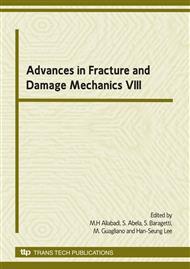p.445
p.449
p.453
p.457
p.461
p.465
p.469
p.473
p.477
Contact Damage of Curved Multi-Layered Ceramics: Prepared by Slip Casting Technique
Abstract:
Contact damage of curved multi-layered systems, consisting of a brittle zirconia (3Y-TZP)/Alumina (Al2O3) coating – prepared by slip casting – on a compliant polymeric substrate from indentation by a hard tungsten carbide sphere is investigated. The essence of this study is to compare the structural performance of layered ceramics, and monolithic ceramic in the brittle coating and compliant substrate of dental crown-like systems. The specimens are loaded at the axis of symmetry. The failure evolution to initiate cracking and final failure patterns in curved multi-layered specimens are compared to those of the single layer specimens of the same thickness and the same study are conducted again with the flat specimens. The onset of fracture is observed in situ using a video camera. It is demonstrated that in all specimens, cone cracking occurs prior to radial cracking, with the latter being defined as the primary mode of catastrophic failure. The multi-layered ZTA (Zirconia Toughened Alumina) specimens prepared by slip casting possessed a distinct final failure pattern in comparison with a single layer specimen. The results of this study provide useful guidelines for building brittle multi-layered coating systems with the functionally graded feature, and complex shapes with geometrical uniformity.
Info:
Periodical:
Pages:
461-464
Citation:
Online since:
October 2009
Authors:
Keywords:
Price:
Сopyright:
© 2010 Trans Tech Publications Ltd. All Rights Reserved
Share:
Citation:


